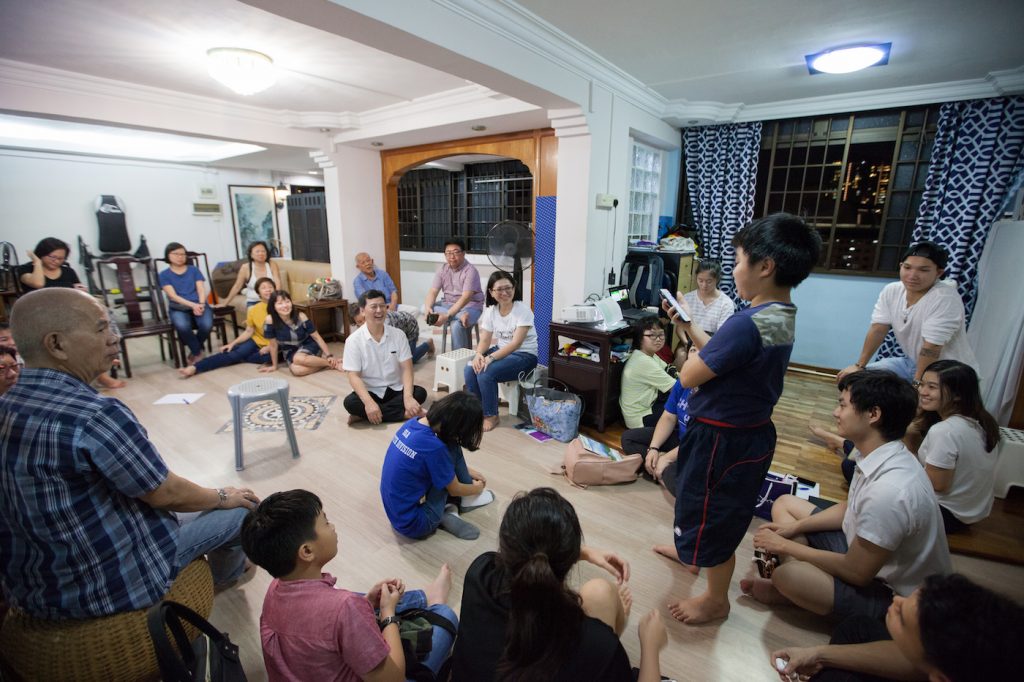The core daily Buddhist practice of SGS members includes the chanting of the phrase “Nam-myoho-renge-kyo” (meaning to devote one’s life to the universal Law of cause and effect) and reciting two significant chapters of the Lotus Sutra – Chapter Two and Chapter 16 – which explain that every individual holds the potential to enlightenment and that life itself is eternal respectively. This daily practice is referred to as gongyo (literally “assiduous practice”).
Buddhism is further characterized by an emphasis on the possibility of inner life transformation – a process of bringing forth our full human potential. This fundamental process of inner life transformation is where we break through our “lesser self”, bound by self-concern and ego, and grow in altruism towards a “greater self”, capable of caring and taking action for the good of others. This practice for oneself and for others in which one aspires to realize one’s happiness together with that of others constitutes the core practice of Nichiren Buddhism.
In accord with the Buddhist teaching that all life and its environment is interrelated (dependent origination), this dynamic process of self-transformation – one from fear to confidence, from destruction to creativity, from hatred to compassion – is the premise of the rejuvenation of human society that will materialize in a peaceful world.
Philosophy and Practice
The Law
Buddhism teaches that a universal Law (Dharma) underlies everything in the universe. This is the very essence of life. One could also think of it as the fundamental rhythm of life and the universe. Nichiren identified this Law or essence as Nam-myoho-renge-kyo. He taught that by correctly carrying out the practice of Buddhism anyone is able to bring their individual life into harmony with the greater life of the universe. The result of this is that one is able to experience greater wisdom, courage, life force and compassion (the qualities of this life-essence). This, practically, is what it means to manifest Buddhahood, or an enlightened life condition.
About Nam-myoho-renge-kyo
The invocation of Nam-myoho-renge-kyo was established by Nichiren on April 28, 1253.
Having studied widely among all the Buddhist sutras, he had concluded that the Lotus Sutra contains the ultimate truth of Buddhism: that everyone without exception has the potential to attain Buddhahood. The title of the Lotus Sutra in its Japanese translation is Myoho-renge-kyo. But to Nichiren, Myoho-renge-kyo was far more than the title of a Buddhist text, it was the expression, in words, of the Law of life which all Buddhist teachings in one way or another seek to clarify. What follows is a brief and unavoidably limited explanation of some of the key concepts expressed by this phrase.
Nam
Nam derives from Sanskrit. A close translation of its meaning is “to devote oneself.” Nichiren established the practice of chanting Nam-myoho-renge-kyo as a means to enable all people to put their lives in harmony or rhythm with the law of life, or Dharma. In the original Sanskrit, nam indicates the elements of action and attitude, and refers therefore to the correct action one needs to take and the attitude one needs to develop in order to attain Buddhahood in this lifetime.
Myoho
Myoho literally means the Mystic Law, and expresses the relationship between the life inherent in the universe and the many different ways this life expresses itself. Myo refers to the very essence of life, which is “invisible” and beyond intellectual understanding. This essence always expresses itself in a tangible form (ho) that can be apprehended by the senses. Phenomena (ho) are changeable, but pervading all such phenomena is a constant reality known as myo.
Renge
Renge means lotus flower. The lotus blooms and produces seeds at the same time, and thus represents the simultaneity of cause and effect. The circumstances and quality of our individual lives are determined by the causes and effects, both good and bad, that we accumulate (through our thoughts, words and actions) at each moment. This is called our “karma.” The law of cause and effect explains that we each have personal responsibility for our own destiny. We create our destiny and we can change it. The most powerful cause we can make is to chant Nam-myoho-renge-kyo; the effect of Buddhahood is simultaneously created in the depths of our life and will definitely manifest in time.
The lotus flower grows and blooms in a muddy pond, and yet remains pristine and free from any defilement, symbolising the emergence of Buddhahood from within the life of an ordinary person.
Kyo
Kyo literally means sutra, the voice or teaching of a Buddha. In this sense, it also means sound, rhythm or vibration. Also, the Chinese character for kyo originally meant the warp in a piece of woven cloth, symbolizing the continuity of life throughout past, present and future. In a broad sense, kyo conveys the concept that all things in the universe are a manifestation of the Mystic Law.
Buddhahood in Daily Life
Discussion Meetings
The development of our Buddhist faith and practice is supported by monthly discussion meetings, Buddhist study and prayer meetings. At these gatherings, believers learn about the Buddhist principles and their applications to everyday life and mutually share experiences on how they have successfully transformed their lives and overcame challenges through their Buddhist practice.

